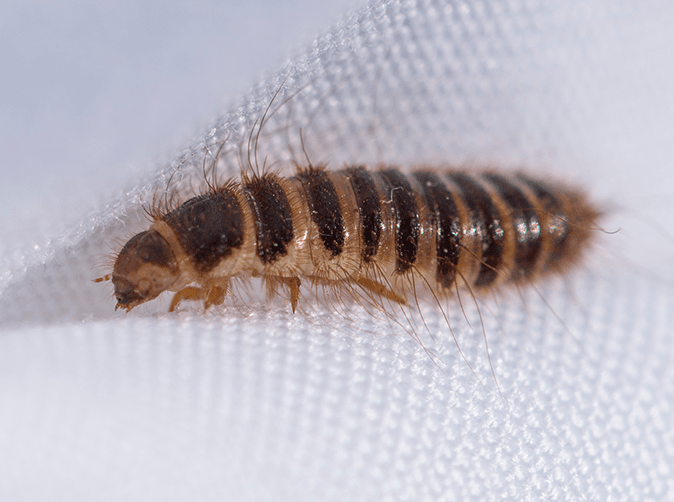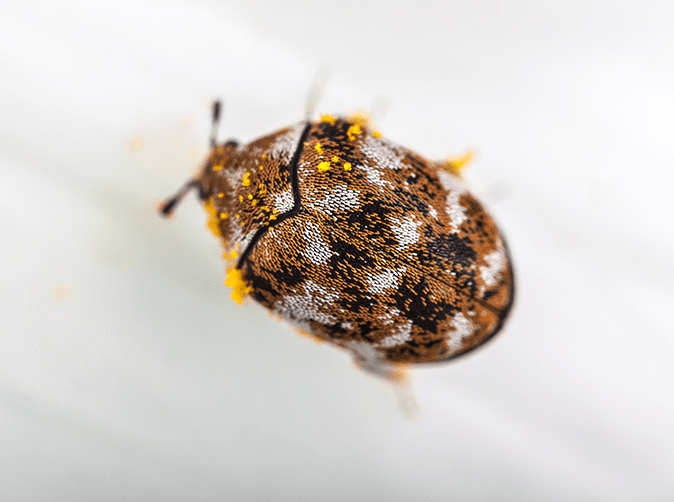FREE ESTIMATE
Request Your Pest Control Estimate
Carpet beetles are found inside homes, warehouses, museums and other buildings. Once inside they may cause serious damage to clothing, furs, carpets and other stored fabric items. The DC Metro area is home to several common species of carpet beetle:
Varied carpet beetle
Common carpet beetle
Furniture carpet beetle (Anthrenus scrophulariae)
The varied carpet beetle adult is black with an irregular pattern of brown, white and dark yellow scales on its elytra (wing covers). It is visible to the human eye at 1/8-3/16 inch in length. They look like small, miniature ladybird beetles (lady bugs) but with a black shell and yellow spots. Varied carpet beetle larvae appear brownish in color and appear to be “hairy” or “bristly.”
Black carpet beetle (Attagenus unicolor)
The black carpet beetle adult is dark brown to oily-black. The body length can range from 1/8 to approximately 3/16 inch. Black carpet beetle larvae are typically seen as having carrot-shaped, or elongated, bodies with a tuft of long bristles at the narrow end. Inside homes, carpet beetles typically deposit their eggs on or near wool carpet and rugs. A female carpet beetle lays around 40 eggs, which take 10 to 20 days to hatch. A female adult carpet beetle can live for 2 to 6 weeks, and a male can live for 2 to 4 weeks. Adults usually appear in spring and early summer. Indoors, they are often seen near windows.
Varied carpet beetles are not considered to be harmful to humans or pets. Carpet beetles are harmful to carpets, furniture and clothing and will often remain a nuisance pest. In rare instances, the bristles on carpet beetle larvae can create skin irritations, causing a sensation of being bitten.

Once larvae turn into adult carpet beetles, they will want to leave the house in order to find pollen. This means that springtime is when they will be most active and you will see large numbers of the beetles on window panes, in their bid to find flowers.

Carpet beetles live in a variety of places. Abandoned bird nests are ideal for carpet beetles to live, especially if they are sheltered in eaves and lofts.
Request Your Pest Control Estimate
Because carpet beetles feed on natural fibers and particles, they are especially attracted to any or all the following:
Wool (including carpets, rugs and other woolen goods)
Animal skins and furs
Stuffed animals
Feathers
Human hair
Pet hair
Leather book bindings
Animal horns
Whalebones
Silk
They also eat dried plant products and silk plants. Inside homes, these “fuzzy” bugs are often found on the floor or around baseboards, in closets, beneath upholstered furniture and on the undersides of carpeting. Carpet beetles, like many other pests, enter the home from the outside. Adult carpet beetles frequent homes and buildings by entering through small cracks and openings around windows, doors, and from underneath siding. They will also use electrical lines and above-ground pipes that lead into the home.
“ They were respectful workers that were excellent, timely, reasonable, and thorough. It was worth every penny!
![]()
Find out what our customers are saying. Click links to read or leave a review.
T. Campbell - Silver Spring, MD
“ We've been using this company for years. They provide consistent, high-quality service. Since we started using American Pest we have had far fewer pest problems, and the few that we've had have been addressed within days.”
M. Usher - Cheltenham, MD
“ My service technician is excellent! He is professional, knowledgeable, and consistently arrives on time. I know my home is in good hands with American Pest.”
V. Maier - Silver Spring, MD
“ American Pest service technicians are always willing to take their time and listen to concerns, answer questions and crawl around checking out areas that may show signs of intruding insects or rodents.”
We align with the best, to bring you the best.




If you have questions about our services, plans, or pricing, we are here for you. Call or fill out the form to communicate by email.